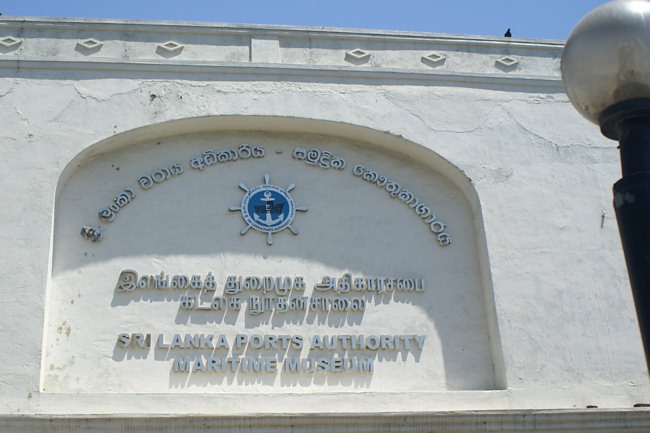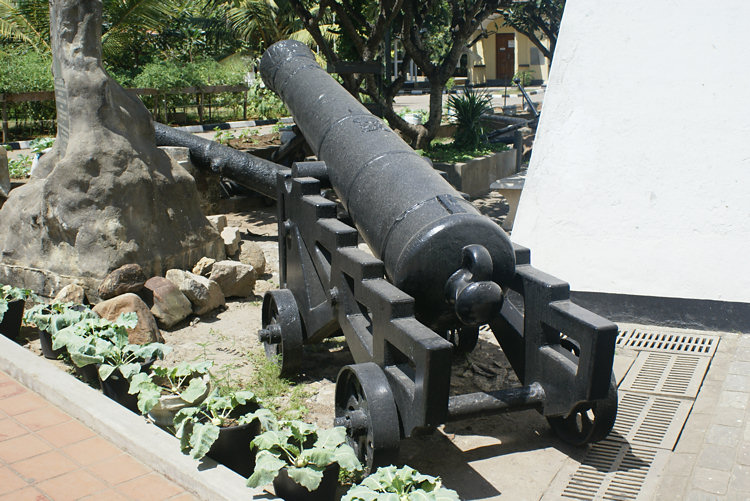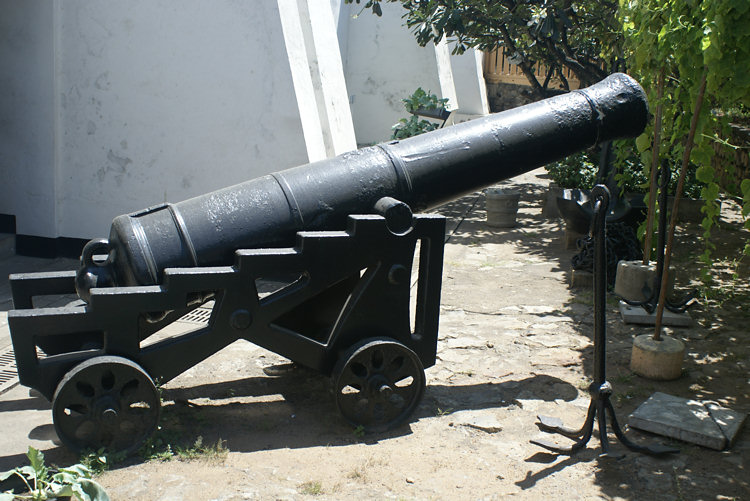Colombo Ports Authority Maritime Museum
The Maritime Museum can be found in the far northern section of the Chaithya Road in Colombo Fort where the road bends around to the Sri Lankan Navy Base.

Entrance to the Colombo Ports Authority Maritime Museum in Sri Lanka
The Road is long so take a Tuktuk and later walk back along the coast. On the bend is the magnificent Sambodhi Chaitya Dagoba that straddles the road. The road is a dead end as the entrance military gates block the road. To the left is a large rectangular block house. It used to be the old Dutch prison built in the late 1600's but now it is home to the Colombo Ports Authority Maritime Museum. It is in the grounds of the temple which I was not expecting. I was looking for a building standing on its own along the side of the road.
There is a small fee to go in. It is nice to get out of the sun for a while (or rain if you are unlucky) The Museum tells the story of the origins of Colombo and its maritime and trading history. Whilst most of Europe was living in mud huts with thatched roofs the Sri Lankans in Colombo were busy running an international trading business.
The Maritime Museum is open every day from 10am to 7pm. Galle in the south of Sri Lanka used to be the main trading port but gradually more and more trade moved to Colombo as port facilities improved with the construction of artificial harbours.

Look for the VOC Dutch East Indies crest on top of this old Dutch Cannon
Colombo has been a trading port for over 2,000 years. It is situated on the mouth of the river Kelani. This allowed goods to be moved down river for export and traded imported goods to be moved upstream to inland markets. Historians have found references to the port of Colombo in documents around the world. It was visited regularly by the Romans, Arab, Indian, African and Chinese traders. Marco Polo recorded that he visited the island on behalf of the Chinese Imperial Court. Many of these traders set up warehouses in Colombo.
The first European Colonial power discovered the islands by accident. The Portuguese were blown off course in 1505. They liked what they saw and decided to stay. They were particularly interested in cinnamon which was in demand in Europe and could fetch a high price. They entered into a contract with the Sri Lankan King Kotte Parakramabahu VIII and obtained the trading rights along the whole southern coast line. They built a fort and expelled their competition, the Muslim Arab traders. The Sri Lankan island at that time was not one unified kingdom. There were other kingdoms that took exception to the involvement of the Portuguese. This resulted in armed conflict and a number of sieges.
The Dutch, who coveted the riches of the island, profited by this conflict. In 1656 they promised King Rajasinha II military help with his war against the Portuguese so long as they were awarded the monopoly on all Sri Lankan trade. The Dutch at that stage were not interested in land, unlike the Portuguese. The Dutch won the last battle when the last remaining 93 Portuguese soldiers surrendered the Colombo fort after a long siege. The Dutch gave the newly captured land to the Sinhalese King but in reality they controlled the commercial interests, especially the cinnamon plantations and the port. The Dutch East India Company (Vereenigde Oost-Indische Compagnie VOC) used Colombo as its Maritime capital

Old Dutch Cannon at the Colombo Maritime Museum in Sri Lanka
The British Navy took control of the Colombo Fort and Port in 1796. The Dutch had been weakened after being conquered by Napoleon. The Dutch leaders had fled to London and as they could no longer control the trade based in Colombo they reluctantly transferred ownership to the British. The Dutch had not been powerful enough to win a war against the central Kingdom of Kandy and thus take ownership of the whole island. The British were strong enough.
The Kingdom of Kandy was offered the chance of being a British protectorate. This was refused. The British only controlled the whole island after they defeated the king of Kandy in 1815.This new colony of the British Empire was called Ceylon. Trade that passed through the port of Colombo increased dramatically. The British introduced more plantations throughout the island for products like coffee, spices, rubber and most importantly Ceylon tea. They even introduced European vegetables to the highland regions.
Sri Lanka obtained its independence in 1948 from the near bankrupt British Government who was recovering from World War Two. Trade has continued to increase in the port, especially after the introduction of containerisation. It is pleasing to see money being put into a museum that with pride tells the story of the Port of Colombo.
The outside of the Maritime Museum is lined with old ships cannon. Some are displayed on their wheeled carriage and others just resting on the wall. Check the top of each cannon to try and find a crest. This is the way to work out if they were Portuguese, Dutch, British or captured French. These cannon are all breach loaded. That means that the cannon shell and the powder case would have been rammed down the front opening of the cannon. If you look closely around the grounds you might see some cannon balls.
Travel books

